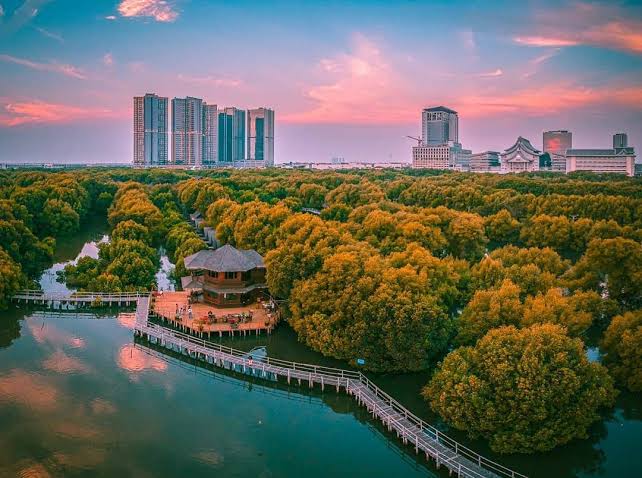Exploration Guide: Trails & Local Wildlife
The Pantai Indah Kapuk Mangrove Forest is one of Jakarta’s hidden natural gems, offering a refreshing escape from the city’s hustle and bustle. Trekking here allows visitors to reconnect with nature, explore wooden trails surrounded by mangrove trees, and observe a variety of local wildlife in their natural habitat. This guide will explore the trekking trails, the unique fauna of the mangroves, and essential tips for maximizing your adventure.
Trails Through the Mangrove Forest
The mangrove forest at Pantai Indah Kapuk is well-maintained, with wooden boardwalks and clearly marked paths that make trekking accessible for beginners and seasoned hikers alike. The main trail stretches approximately 2 kilometers, forming a loop that allows visitors to explore the forest without retracing their steps.
Along the path, wooden observation platforms are strategically placed to offer panoramic views of the tidal waters and dense mangrove trees. These platforms are excellent spots for photography or simply sitting quietly to enjoy the sounds of the forest—birds chirping, leaves rustling, and the distant sound of waves lapping at the shoreline.
For those seeking a longer trek, several branching trails lead deeper into less-traveled parts of the forest. These narrower paths are ideal for spotting smaller wildlife and experiencing a more immersive natural environment. Visitors are advised to wear sturdy footwear as some sections can become muddy during high tide or after heavy rain.
Observing Local Wildlife
The Pantai Indah Kapuk mangrove forest is home to a diverse array of local wildlife. Birdwatchers can expect to see herons, kingfishers, egrets, and several species of migratory birds depending on the season. Early morning or late afternoon is the best time to observe these birds as they forage for food along the muddy shores and tree branches.
Mangrove crabs, mudskippers, and small fish thrive in the shallow waters between the roots of the mangrove trees. These creatures play a crucial role in the ecosystem by helping to recycle nutrients and maintain the health of the forest floor. Visitors should tread lightly and avoid disturbing the wildlife.
In addition to the aquatic life, the forest canopy shelters monkeys and occasionally civets, adding an element of excitement to the trek. Always maintain a safe distance from animals and refrain from feeding them, as human food can harm their natural diet.
Baca Juga: Viral Bocah SD Naik Sepeda Listrik
Tips for a Successful Trek
-
Timing is Everything: Visiting early in the morning or late in the afternoon allows for cooler temperatures and better chances to see wildlife. Midday can be hot and less comfortable for walking.
-
Dress Appropriately: Light, breathable clothing is ideal, but long sleeves and pants can protect against insect bites. Comfortable, waterproof shoes are a must for muddy sections.
-
Bring Essentials: Water, snacks, sunscreen, and a hat are necessary for longer treks. Binoculars and a camera can enhance your wildlife observation experience.
-
Respect Nature: Do not litter or damage plants. Stick to the marked trails to protect both the environment and yourself.
-
Safety First: Although the trails are generally safe, some areas can be slippery. Walking sticks or trekking poles can provide extra stability.
Educational and Environmental Value
Trekking through the mangrove forest is not only a recreational activity—it also offers educational benefits. Schools and community groups often organize nature walks to teach children about mangrove ecosystems, tidal patterns, and local wildlife. These excursions foster environmental awareness and encourage responsible behavior toward nature.
Mangroves act as natural buffers, protecting coastal areas from erosion and flooding. By visiting and supporting the forest, trekkers indirectly contribute to conservation efforts that maintain the delicate balance of coastal ecosystems.
Best Practices for Photography
Mangrove forests provide excellent opportunities for photography, especially wildlife and landscape shots. The interplay of sunlight and shadow between the dense roots and canopy creates dramatic visuals. Early morning light, when mist may still linger, offers a magical atmosphere for photos.
When photographing wildlife, patience is key. Move slowly and avoid sudden movements to prevent scaring animals away. Using a zoom lens allows for close-up shots without disturbing the habitat.
Baca Juga: Tolak Pengajian Bayar Rp1 Juta Bekasi
Conservation Efforts and Community Engagement
Local communities play an essential role in preserving the Pantai Indah Kapuk mangrove forest. Volunteer programs and guided tours often include educational sessions about the importance of mangroves and the threats they face, such as pollution and urban encroachment.
Participating in these initiatives provides trekkers with a deeper understanding of the ecosystem and allows them to contribute to conservation efforts directly. Simple actions, such as picking up trash or planting mangrove saplings, can have a significant impact on the health and sustainability of the forest.
Conclusion
Trekking in the mangrove forest of Pantai Indah Kapuk offers an immersive experience combining nature, education, and adventure. From exploring well-maintained trails to observing diverse wildlife, this urban green space allows visitors to appreciate the vital role mangroves play in coastal ecosystems. Proper preparation, respect for wildlife, and awareness of environmental conservation can enhance your trek, making it both enjoyable and meaningful.
